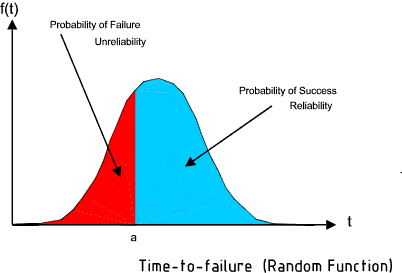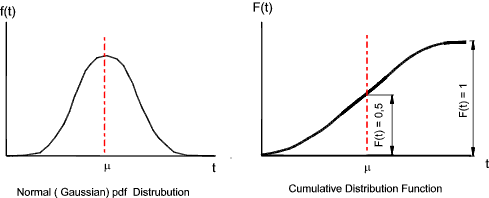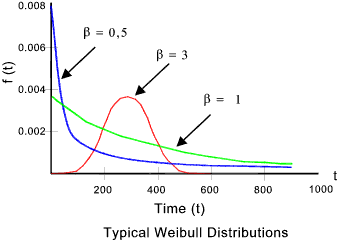Statistics Index Page Failure Distributions
Note: The information below is provided as an overview of failure distributions.. More detailed
and reliable information is provided at the sites linked at the bottom of this page...
|
Introduction In determining the lifetime reliability of a population of components (bearings, seals, gears etc.)
sample information is obtained from testing programmes and operational feedback on the failure
history of components belonging to the population. From the information obtained
it is possible to produce a graph of the probability density function f(t).
This is a plot of the frequency at which components fail as a function of time divided by the whole
population.  Associated with the pdf is the Cumulative Density Function F(t). This is simply
a plot of the cumulative fraction of the failure population against time. It is the integral
of the f(t) against time (t).
This effectively means that at time 0 no failures have occurred.
At infinity the whole population of components will have failed. Reliability
The reliability may be expressed that.. for time = a ( e.g 10 years ) there is a chance of the item surviving (not failing)... = 1 in 10 is likely to fail. Hazard Rate
The hazard rate may be expressed as... the failure rate will be 2 x 10 -4 (failures /unit time) or 2 failures per 10 4 time units Mean Life Function The mean life provides the average life to failure of components is also called the
Mean Life Between Failures (MLBF) and the Mean Time to Failures (MTTF)
The MTTF /MTBF may be expressed as say 1,000 hours at which 50% of units have failed Failure Distributions The pdf curve can take many forms....Some of the different distributions are listed below Normal Distribution One curve representing purely random events
is the normal (gaussian) curve.
The equation for the normal distribution is :
Both of these parameters are estimated from the data, i.e. the mean and standard deviation of the data.
From these parameters f(t) is fully defined enabling evaluation of f(t) from any value of t.
The Lognormal Distribution The lognormal distribution is commonly used for general reliability analysis, cycles
to failure in fatigue and material strengths and loading.
Weibull Distribution The Weibull distribution is a general-purpose reliability distribution used to model material strength, times-to-failure of electronic and mechanical components, equipment, or systems. In its most general case, the three-parameter Weibull pdf is defined by:
with three parameters, where :
If the location parameter γ is assumed to be zero
then the distribution is known as the two-parameter Weibull distribution...
The β = shape parameter gives indications on the prevalent failure modes.
The Exponential Distribution The exponential distribution is a commonly used distribution in reliability
engineering. Mathematically, it is a fairly simple distribution,
which sometimes leads to its use in inappropriate situations.
This distribution is used to model the behavior of units that have a
constant failure rate.
The mean time to failure of this distribution is
If the location parameter γ is assumed to be zero then the distribution is called the one parameter exponential distribution.
The mean time to failure and the reliability of this distribution is
|
Links to Failure Distributions
|
|
Reliability /Safety Index Page
Statistics Index Page
Please Send Comments to Roy Beardmore













